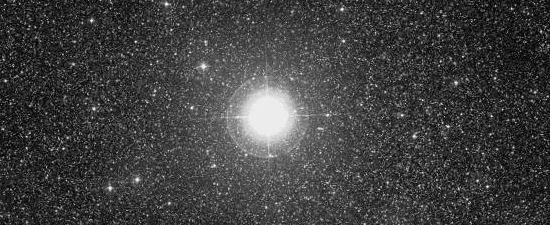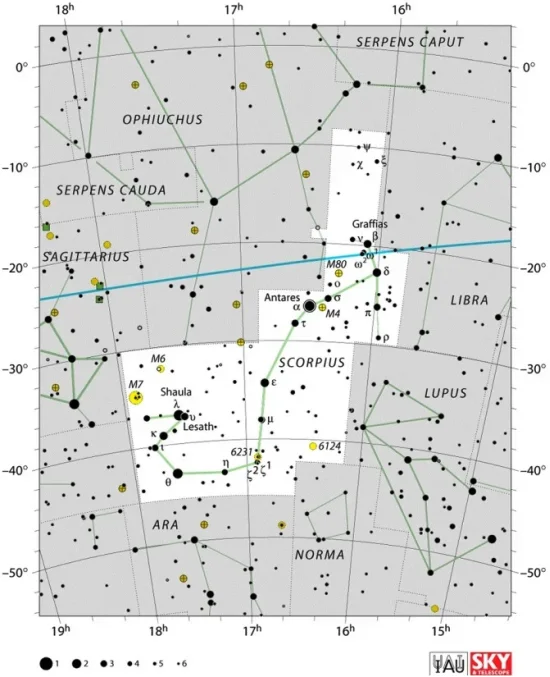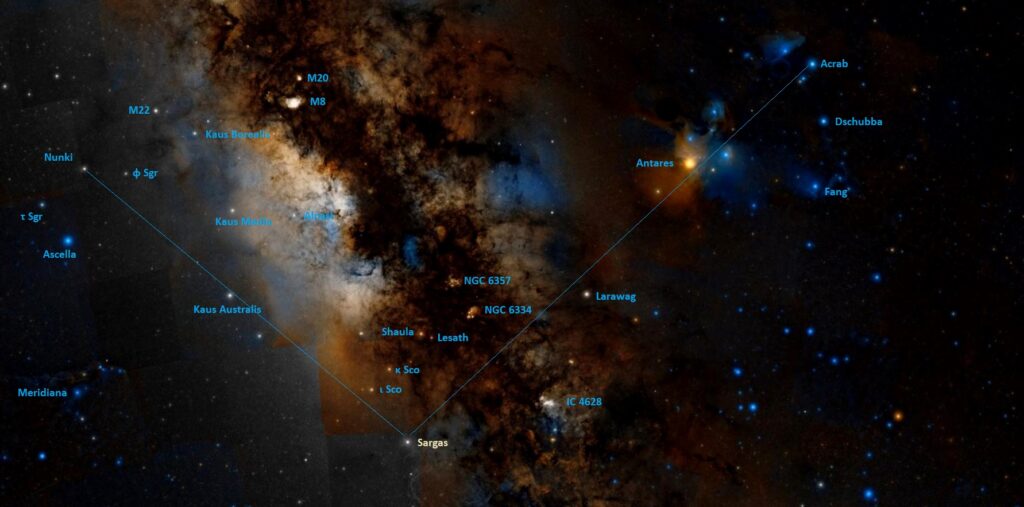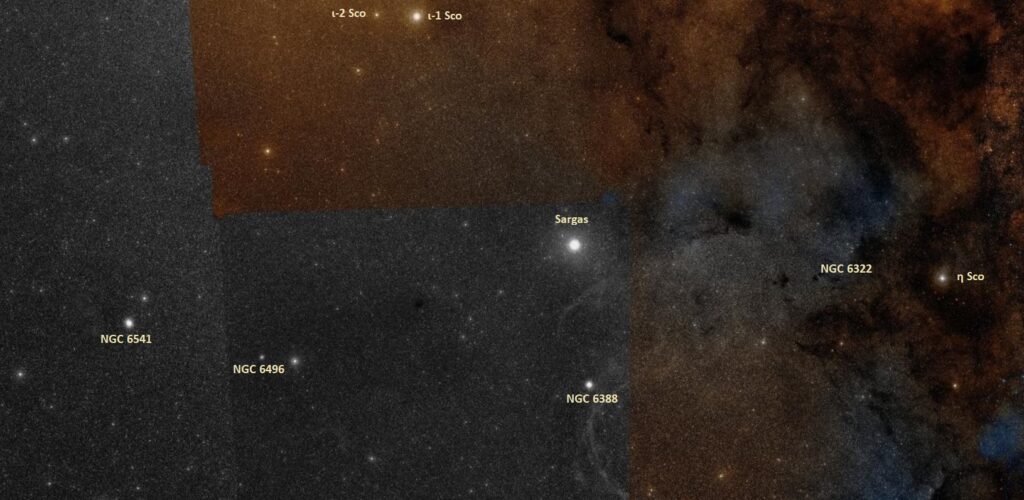Sargas, Theta Scorpii A (θ Sco A), is a white giant star located in the constellation Scorpius. It is the primary component of the Theta Scorpii binary star system. With a combined apparent magnitude of 1.84, Theta Scorpii is the third brightest point of light in Scorpius, after Antares and Shaula. It lies at an approximate distance of 300 light years from Earth. It marks the southern curve of the Scorpion’s tail.
Star system
Theta Scorpii has the stellar classification F1 III, indicating a giant star appearing white or yellow-white in colour. Some sources give the spectral type F0 II, indicating a bright giant.
The star system consists of Theta Scorpii A (Sargas) and Theta Scorpii B, a fainter companion at a separation of 6.470 arcseconds, detected in 2008. The companion has an apparent magnitude of 5.36.
Sargas has a mass about 5.66 times that of the Sun and a radius 26 times solar. With a surface temperature of 7,268 K, it shines with 1,834 solar luminosities.

Sargas (Theta Scorpii), image: Wikisky
Sargas started its life as a blue (class B) main sequence star about 100 million years ago and has swelled to its current size as it evolved away from the main sequence. As it continues to expand and cool, it will become a Cepheid variable in less than a million years, and then evolve into a red giant. Sargas is not massive enough to be a supernova candidate. Instead, when it comes to the end of its life cycle, it will expel its outer layers to form a planetary nebula and meet its end as a white dwarf.
Sargas is a very fast spinner, with a projected rotational velocity of 125 km/s. Due to its large size, it still takes about 10 days to complete a rotation. As a result of its fast rotation, it has a flattened shape and its radius at the equator is 19% larger than its polar radius. Because the star’s poles are closer to the centre of mass, they are also hotter and more luminous than the equatorial region. This makes Sargas an example of gravity darkening, a phenomenon commonly seen in fast spinning stars with oblate shapes.
Facts
On average, Sargas is the 39th brightest star in the sky. It is about as bright as Regor in the constellation Vela, Kaus Australis in Sagittarius, Alkaid in Ursa Major, and Wezen in Canis Major, and it just outshines Avior in Carina, Menkalinan in Auriga, Atria in Triangulum Australe, and Alhena in Gemini.
Sargas is one of the 27 bright stars featured on the flag of Brazil. Each star on the flag represents a Brazilian federative unit and Sargas symbolizes the state of Alagoas. Other Scorpius stars represented on the flag are Antares (Alpha Scorpii), Acrab (Beta Scorpii), Larawag (Epsilon Scorpii), Shaula (Lambda Scorpii), Iota Scorpii, Kappa Scorpii, and Mu Scorpii (Xamidimura and Pipirima).
Name
The name Sargas (pronunciation: /ˈsɑːrɡæs/) may be derived from the Sumerian ŠAR.GAZ, denoting a weapon of the god Marduk, or from the Persian word for “arrowhead.”
The name was approved by the International Astronomical Union’s (IAU) Working Group on Star Names (WGSN) on August 21, 2016. It formally applies only to the component Theta Scorpii A.
Theta Scorpii has also traditionally been known as Girtab. The name is also Sumerian in origin and means “scorpion.” Today, the name Girtab is informally used for Kappa Scorpii, which lies a bit more to the north and is also part of the Scorpion’s tail.
The Chinese know Sargas as 尾宿五 (Wěi Xiù wǔ), the Fifth Star of Tail. The Chinese Tail asterism is part of the Tail mansion and represents the tail of the Azure Dragon. It is formed by Sargas with Xamidimura (Mu1 Scorpii), Larawag (Epsilon Scorpii), Zeta1 and Zeta2 Scorpii, Eta Scorpii, Iota1 Scorpii, Kappa Scorpii, Shaula (Lambda Scorpii), and Lesath (Upsilon Scorpii).
Location
Sargas is one of the southernmost bright stars in Scorpius, lying to the south of Shaula and Lesath, the stars that mark the tip of the Scorpion’s tail. It does not rise very high above the horizon for mid-northern observers. Those living north of the latitude 47° N cannot see it at all.
Sargas can be found using two bright asterisms in the vicinity: the Teapot, formed by the brightest stars of Sagittarius, and the Fish Hook, formed by the brightest stars of Scorpius. A line from Nunki, the top left star of the Teapot, through Kaus Australis, the bottom right star, leads towards Sargas. Alternatively, a line extended from Acrab, the top star marking the Scorpion’s claws, through Antares, the brightest star in Scorpius, also points in the direction of Sargas.
Sargas can be used to find several relatively bright star clusters. NGC 6541, a globular cluster in the neighbouring constellation Corona Australis, has an apparent magnitude of 6.3 and lies at a distance of 22,800 light years from Earth. NGC 6496, another globular cluster, is located in Scorpius and lies at a distance of 36,900 light years. The globular cluster NGC 6388 has a visual magnitude of 6.72 and lies 32,300 light years away and the open cluster NGC 6322 near the white subgiant Eta Scorpii has an apparent magnitude of 6.00 and lies at a distance of 3,247 light years.
Constellation
Sargas is located in the constellation Scorpius. Like all zodiac constellations, Scorpius is one of the 48 Greek constellations, first listed by the astronomer Claudius Ptolemy of Alexandria in his Almagest in the 2nd century CE. The constellation represents the scorpion that stung Orion, the Hunter in Greek mythology.

Scorpius constellation map by IAU and Sky&Telescope magazine
Scorpius is not particularly large – with an area of 497 square degrees, it is the 33rd constellation in size out of 88 – but it is one of the most distinctive constellations in the sky, with its brightest stars outlining the scorpion’s claws and tail with a stinger.
Scorpius is best known for being home to the red supergiant Antares, the 15th brightest star in the sky, and for the Fish Hook asterism, formed by Antares with other bright stars in the constellation.
Located in a rich field of the Milky Way, the constellation contains many notable deep sky objects. In addition to those near Sargas, these include the globular clusters Messier 4, Messier 80 and NGC 6144, the open clusters Messier 6 (the Butterfly Cluster), Messier 7 (the Ptolemy Cluster), NGC 6821 and NGC 6231 (the Northern Jewel Box Cluster), the diffuse nebula NGC 6357 (the War and Peace Nebula), the emission nebula NGC 6334 (the Cat’s Paw Nebula), and the bipolar planetary nebula NGC 6302 (the Bug or Butterfly Nebula).
The best time of year to observe the stars and deep sky objects of Scorpius is during the month of July, when the constellation is prominent in the evening sky. The entire constellation is visible between the latitudes 40° N and 90° S.
The 10 brightest stars in Scorpius are Antares (Alpha Sco A, mag. 0.6 – 1.6), Shaula (Lambda Sco A, mag. 1.62), Sargas (Theta Sco A, mag. 1.84), Dschubba (Delta Sco, mag 2.307), Larawag (Epsilon Sco, mag. 2.31), Kappa Scorpii (mag. 2.39), Acrab (Beta Sco, mag. 2.62), Lesath (Upsilon Sco, mag. 2.70), Paikauhale (Tau Sco, mag. 2.82), and Fang (Pi Sco, mag. 2.89).
Sargas – Theta Scorpii
| Spectral class | F1 III or F0 II |
| U-B colour indeks | +0.21 |
| B-V colour indeks | +0.40 |
| Apparent magnitude | 1.84 (1.862 + 6.22) |
| Absolute magnitude | -2.71 |
| Distance | 300 light years (90 parsecs) |
| Parallax | 10.86 ± 1.49 mas |
| Radial velocity | +1.4 km/s |
| Proper motion | RA: +5.54 ± 2.01 mas/yr |
| Dec.: -3.12 ± 1.42 mas/yr | |
| Mass | 5.66 ± 0.65 M☉ |
| Luminosity | 1,834 L☉ |
| Radius | 26 R☉ |
| Temperature | 7,268 K |
| Age | ∼100 ± 15 million years |
| Rotational velocity | 125 km/s |
| Surface gravity | 2.4 ± 0.2 cgs |
| Constellation | Scorpius |
| Right ascension | 17h 37m 19.12985s |
| Declination | –42° 59′ 52.1808″ |
| Names and designations | Sargas, Girtab, Theta Scorpii, θ Sco, 160 G. Scorpii, HD 159532, HR 6553, HIP 86228, SAO 228201, FK5 654, GC 23857, GCRV 10165, CD−42° 12312, CCDM J17373−4300, GSC 07892-07679, IRAS 17337-4258, 2MASS J17371913-4259522, PLX 3998, PPM 323186, TYC 7892-7679-1, WDS J17373-4300A, WISE J173719.06-425951.7 |

